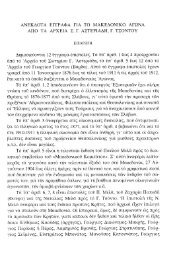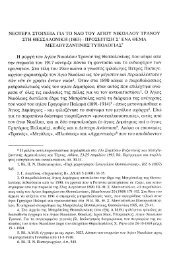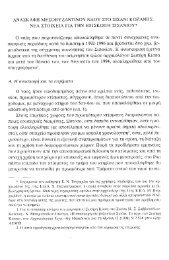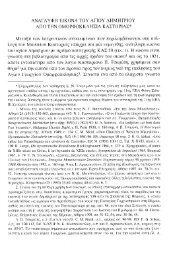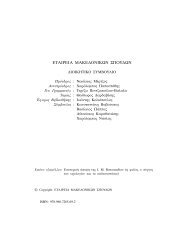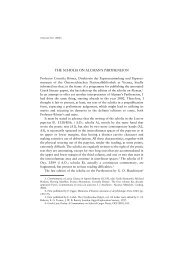- Page 1: GREEK EDUCATION IN MONASTIR - PELAG
- Page 4 and 5: Translation: Janet Koniordos SOCIET
- Page 6 and 7: 6 ANTONIS M. KOLTSIDAS ies to trans
- Page 8 and 9: 8 ANTONIS M. KOLTSIDAS 1. The inter
- Page 12 and 13: 12 ANTONIS M. KOLTSIDAS tural insti
- Page 14 and 15: 14 ANTONIS M. KOLTSIDAS entity, and
- Page 16 and 17: 16 ANTONIS M. KOLTSIDAS active soci
- Page 18 and 19: 18 ANTONIS M. KOLTSIDAS 2. The Gree
- Page 20 and 21: 20 ANTONIS M. KOLTSIDAS Figure 1. I
- Page 22 and 23: 22 ANTONIS M. KOLTSIDAS Figure 2. I
- Page 24 and 25: . GREEK EDUCATION IN MONASTIR ORGAN
- Page 26 and 27: 26 ANTONIS M. KOLTSIDAS In 1869 Mon
- Page 28 and 29: 28 ANTONIS M. KOLTSIDAS Greece coul
- Page 30 and 31: 30 ANTONIS M. KOLTSIDAS School, 686
- Page 32 and 33: 32 ANTONIS M. KOLTSIDAS 2. The most
- Page 34 and 35: 34 ANTONIS M. KOLTSIDAS teachers if
- Page 36 and 37: 36 b) The Gymnasium of Monastir ANT
- Page 38 and 39: 38 ANTONIS M. KOLTSIDAS rovo, Milov
- Page 40 and 41: 40 ANTONIS M. KOLTSIDAS Figure 13.
- Page 42 and 43: 42 ANTONIS M. KOLTSIDAS TABLE 3 Cla
- Page 44 and 45: 44 ANTONIS M. KOLTSIDAS TABLE 5 Sub
- Page 46 and 47: 46 ANTONIS M. KOLTSIDAS TABLE 6 Cur
- Page 48 and 49: 48 ANTONIS M. KOLTSIDAS Careful exa
- Page 50 and 51: 50 ANTONIS M. KOLTSIDAS school (gym
- Page 52 and 53: 52 ANTONIS M. KOLTSIDAS an enrolmen
- Page 54 and 55: 54 ANTONIS M. KOLTSIDAS In another
- Page 56 and 57: 56 ANTONIS M. KOLTSIDAS Figure 27.
- Page 58 and 59: REGULATIONS OF THE RESIDENCE OF THE
- Page 60 and 61:
60 ANTONIS M. KOLTSIDAS Breakfast:
- Page 62 and 63:
62 ANTONIS M. KOLTSIDAS 3. Anyone w
- Page 64 and 65:
64 ANTONIS M. KOLTSIDAS 2. She shal
- Page 66 and 67:
66 ANTONIS M. KOLTSIDAS TABLE 8 87
- Page 68 and 69:
68 ANTONIS M. KOLTSIDAS should now
- Page 70 and 71:
70 ANTONIS M. KOLTSIDAS f) Central
- Page 72 and 73:
72 ANTONIS M. KOLTSIDAS TABLE 9 Pup
- Page 74 and 75:
74 ANTONIS M. KOLTSIDAS TABLE 10 Su
- Page 76 and 77:
76 ANTONIS M. KOLTSIDAS 1937); vii)
- Page 78 and 79:
78 ANTONIS M. KOLTSIDAS Figure 39.
- Page 80 and 81:
80 ANTONIS M. KOLTSIDAS Bishop, who
- Page 82 and 83:
82 ANTONIS M. KOLTSIDAS 5. The stud
- Page 84 and 85:
84 ANTONIS M. KOLTSIDAS Registers o
- Page 86 and 87:
86 ANTONIS M. KOLTSIDAS Elementary
- Page 88 and 89:
88 ANTONIS M. KOLTSIDAS Fig. 43. (
- Page 90 and 91:
90 ANTONIS M. KOLTSIDAS affairs of
- Page 92 and 93:
92 ANTONIS M. KOLTSIDAS TABLE 12 Sc
- Page 94 and 95:
94 ANTONIS M. KOLTSIDAS What is sur
- Page 96 and 97:
96 ANTONIS M. KOLTSIDAS TABLE 13 Sa
- Page 98 and 99:
98 ANTONIS M. KOLTSIDAS b) Hours,
- Page 100 and 101:
100 ANTONIS M. KOLTSIDAS School yea
- Page 102 and 103:
102 ANTONIS M. KOLTSIDAS Figure 48.
- Page 104 and 105:
104 ANTONIS M. KOLTSIDAS that basis
- Page 106 and 107:
106 Name . Dalengas P. Ilias Th. Ch
- Page 108 and 109:
108 ANTONIS M. KOLTSIDAS Figure 50.
- Page 110 and 111:
110 ANTONIS M. KOLTSIDAS Figure 51.
- Page 112 and 113:
112 ANTONIS M. KOLTSIDAS a) The Gen
- Page 114 and 115:
114 ANTONIS M. KOLTSIDAS c) School
- Page 116 and 117:
116 ANTONIS M. KOLTSIDAS were a rev
- Page 118 and 119:
118 ANTONIS M. KOLTSIDAS Figure 53.
- Page 120 and 121:
120 ANTONIS M. KOLTSIDAS 2. We cite
- Page 122 and 123:
122 Religious service. 1. Hymn. 2.
- Page 124 and 125:
124 ANTONIS M. KOLTSIDAS b) Cultura
- Page 126 and 127:
126 ANTONIS M. KOLTSIDAS Parades -
- Page 128 and 129:
128 ANTONIS M. KOLTSIDAS tir”, th
- Page 130 and 131:
130 ANTONIS M. KOLTSIDAS “Melissa
- Page 132 and 133:
132 ANTONIS M. KOLTSIDAS b) “Gree
- Page 134 and 135:
. THE INSIGNIFICANT ACTIVITY OF THE
- Page 136 and 137:
136 ANTONIS M. KOLTSIDAS A few year
- Page 138 and 139:
138 ANTONIS M. KOLTSIDAS Figure 63.
- Page 140 and 141:
140 ANTONIS M. KOLTSIDAS Figures 66
- Page 142 and 143:
142 ANTONIS M. KOLTSIDAS Figure 69.
- Page 144 and 145:
MONASTIR TODAY ____________________
- Page 146 and 147:
146 ANTONIS M. KOLTSIDAS Figures 73
- Page 148 and 149:
148 ANTONIS M. KOLTSIDAS Figures 77
- Page 150 and 151:
150 ANTONIS M. KOLTSIDAS Figures 84
- Page 152 and 153:
152 ANTONIS M. KOLTSIDAS Figures 88
- Page 154 and 155:
154 ANTONIS M. KOLTSIDAS Figures 92
- Page 156 and 157:
156 ANTONIS M. KOLTSIDAS Figures 96
- Page 158 and 159:
158 ANTONIS M. KOLTSIDAS Figures 10
- Page 160 and 161:
IV. MONASTIR AS CULTURAL CENTRE: OR
- Page 162 and 163:
162 b) The “Society of Friends”
- Page 164 and 165:
164 c) “Pronoia” ANTONIS M. KOL
- Page 166 and 167:
166 e) “Lyra” ANTONIS M. KOLTSI
- Page 168 and 169:
168 ANTONIS M. KOLTSIDAS could lear
- Page 170 and 171:
170 ANTONIS M. KOLTSIDAS School Boa
- Page 172 and 173:
172 ANTONIS M. KOLTSIDAS Figures 11
- Page 174 and 175:
174 ANTONIS M. KOLTSIDAS Figure 113
- Page 176 and 177:
176 ANTONIS M. KOLTSIDAS We do not
- Page 178 and 179:
178 ANTONIS M. KOLTSIDAS Figures 11
- Page 180 and 181:
180 ANTONIS M. KOLTSIDAS All these
- Page 182 and 183:
182 ANTONIS M. KOLTSIDAS turned. Be
- Page 184 and 185:
184 ANTONIS M. KOLTSIDAS of the cit
- Page 186 and 187:
186 ANTONIS M. KOLTSIDAS of 2000-25
- Page 188 and 189:
188 ANTONIS M. KOLTSIDAS the proper
- Page 190 and 191:
190 ANTONIS M. KOLTSIDAS Schools of
- Page 192 and 193:
192 ANTONIS M. KOLTSIDAS story of t
- Page 194 and 195:
194 ANTONIS M. KOLTSIDAS When his p
- Page 196 and 197:
196 ANTONIS M. KOLTSIDAS Figure 126
- Page 198 and 199:
198 ANTONIS M. KOLTSIDAS A patriot
- Page 200 and 201:
200 ANTONIS M. KOLTSIDAS o) Evangel
- Page 202 and 203:
202 ANTONIS M. KOLTSIDAS Figure 129
- Page 204 and 205:
204 ANTONIS M. KOLTSIDAS WHO TOOK I
- Page 206 and 207:
206 ANTONIS M. KOLTSIDAS The consul
- Page 208 and 209:
208 ANTONIS M. KOLTSIDAS an activit
- Page 210 and 211:
210 ANTONIS M. KOLTSIDAS Upon leavi
- Page 212 and 213:
212 f) Anastasios G. Tsallis ANTONI
- Page 214 and 215:
214 ANTONIS M. KOLTSIDAS 1913, Mona
- Page 216 and 217:
216 ANTONIS M. KOLTSIDAS [A stalwar
- Page 218 and 219:
218 ANTONIS M. KOLTSIDAS (
- Page 220 and 221:
220 ANTONIS M. KOLTSIDAS
- Page 222 and 223:
222 ANTONIS M. KOLTSIDAS ,
- Page 224 and 225:
224 ANTONIS M. KOLTSIDAS -
- Page 226 and 227:
226 » » . ANTONIS M. K
- Page 228 and 229:
228 ANTONIS M. KOLTSIDAS -
- Page 230 and 231:
230 ANTONIS M. KOLTSIDAS .,
- Page 232 and 233:
232 ANTONIS M. KOLTSIDAS ., .
- Page 234 and 235:
234 ANTONIS M. KOLTSIDAS - 2000
- Page 236 and 237:
236 ANTONIS M. KOLTSIDAS - 4000
- Page 238 and 239:
238 ANTONIS M. KOLTSIDAS .,
- Page 240 and 241:
240 ANTONIS M. KOLTSIDAS ,
- Page 242 and 243:
242 ANTONIS M. KOLTSIDAS Füves Öd
- Page 244 and 245:
244 ANTONIS M. KOLTSIDAS Spiridonak
- Page 246 and 247:
246 Chlorinon, 11 Chrisafis Th., 10
- Page 248 and 249:
248 Junior Teachers’ Training Col
- Page 250 and 251:
250 Modis G. Ch., 77, 166, 167, 171
- Page 252 and 253:
252 Routsoni Olympia, 53 Sagiaxis G
- Page 254:
254 Vodena, 19 Volos, 204 Vosdos Th



